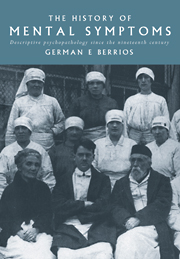Book contents
- Frontmatter
- Contents
- PREFACE
- ACKNOWLEDGEMENTS
- INTRODUCTION
- PART I The object of inquiry
- PART II Cognition and consciousness
- CHAPTER 3 Disorders of perception
- CHAPTER 4 Thought disorder
- CHAPTER 5 Delusions
- CHAPTER 6 Obsessions and compulsions
- CHAPTER 7 Mental Retardation
- CHAPTER 8 Cognitive impairment
- CHAPTER 9 Memory and its disorders
- CHAPTER 10 Consciousness and its disorders
- PART III Mood and emotions
- PART IV Volition and action
- PART V Miscellany
- REFERENCES
- NAME INDEX
- SUBJECT INDEX
CHAPTER 3 - Disorders of perception
from PART II - Cognition and consciousness
Published online by Cambridge University Press: 08 January 2010
- Frontmatter
- Contents
- PREFACE
- ACKNOWLEDGEMENTS
- INTRODUCTION
- PART I The object of inquiry
- PART II Cognition and consciousness
- CHAPTER 3 Disorders of perception
- CHAPTER 4 Thought disorder
- CHAPTER 5 Delusions
- CHAPTER 6 Obsessions and compulsions
- CHAPTER 7 Mental Retardation
- CHAPTER 8 Cognitive impairment
- CHAPTER 9 Memory and its disorders
- CHAPTER 10 Consciousness and its disorders
- PART III Mood and emotions
- PART IV Volition and action
- PART V Miscellany
- REFERENCES
- NAME INDEX
- SUBJECT INDEX
Summary
There are excellent accounts of the history of hallucination and illusion but few in the English language. Hallucination and illusion name reports of experiences ascribed to perception: illusion is defined as a perceptual distortion of a stimulus, and hallucination as a perceptual declaration, of varied degree of conviction, in the absence of a relevant external stimulus. The theoretical basis for this distinction was set during the nineteenth century, although it had already been noticed by earlier writers.
Before the nineteenth century
Experiences redolent of hallucinations and illusions are part of the common baggage of humanity. Variously named, these experiences were in earlier times culturally integrated and semantically pregnant, i.e. their content was believed to carry a message for the individual or the world. That this feature of hallucinations has been mostly lost is a consequence of their ‘medicalization’ during the eighteenth century. During this period, hallucinations were considered as independent ‘diseases’; indeed, the view that they were ‘symptoms’, i.e. fragments of behaviour common to various diseases is a nineteenth century invention. The absence of an entry for hallucination in the French Encyclopaedia suggests that, up to the 1750s, it had not yet reached the status of other ‘psychiatric’ terms. Hunter and McAlpine have none the less shown that since the sixteenth century, hallucinatory behaviours were frequently mentioned; after 1700, Hartley and Battie added a further dimension by explaining these phenomena in terms of vibratory neurophy siology.
In 1770, the French Dufour suggested that ‘fallacies of the senses’ might cause delusions: ‘The false impression of the external senses, then, must necessarily create disorder and confusion in a person's conduct; because it happens most frequently, that they determine his actions.
- Type
- Chapter
- Information
- The History of Mental SymptomsDescriptive Psychopathology since the Nineteenth Century, pp. 35 - 70Publisher: Cambridge University PressPrint publication year: 1996
- 1
- Cited by



